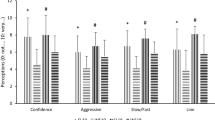Abstract
Laser class sailors have to hike out, i.e. hook their feet under the toe straps near the centreline of the boat and hold their upper bodies over the edge of the boat, to counteract the heeling forces generated by the sails. To identify the parameters that are associated with maximal hiking performance, this cross-sectional observational study measures various knee extensor and hip flexor muscle performance characteristics in 55 Laser sailors and correlates each with the area-under-the-curve hiking moment over 3 min of hiking on a hiking dynamometer (HM180). Our results showed that higher body mass and HM180 were significantly associated with better race scores (Spearman’s rho = − 0.69 and − 0.62, respectively, both P < 0.01) in male sailors who participated in the National Inter-School Laser competition. Body mass (Pearson’s correlation coefficient, r ≥ 0.95, P < 0.01 in both males and females), maximum voluntary isometric strength of the quadriceps (r ≥ 0.80, P < 0.01 in both males and females), and 3-RM knee extension strength (r ≥ 0.80, P < 0.01 in both males and females) were associated with a higher HM180. The correlations between height, abdominal muscle endurance (crunches), explosive lower body strength (vertical jumps), cycling time-to-exhaustion, quadriceps strength endurance, or isometric quadriceps endurance with incremental loads (bucket test), and HM180 were weaker (r < 0.60). HM180 may be a useful performance indicator for Laser racing. Since strength measures correlated well with HM180, greater emphasis should be placed on developing maximum strength in the quadriceps to improve maximal hiking performance.

Similar content being viewed by others
References
Blackburn M (2000a) Protocols for the physiological assessment of sailors. In: Gore CJ (ed) Physiological tests for elite athletes. Australian Sports Commission, Human Kinetics, Champaign, pp 345–356
Blackburn M (2000b). Sailing fitness. In: Tan B (ed) The complete introduction to Laser racing. Singapore Sports Council, Singapore, pp 173–200
Blackburn M, Hubinger L (1995) Determination of physiological profiles and exercise training programs for competitive dinghy sailors. Scientific report. National Sports Research Centre, Australian Sports Commission
Bosco C, Luhtanen P, Komi PV (1983) A simple method for measurement of mechanical power in jumping. Eur J Appl Physiol Occup Physiol 50:273–282
De Vito G, Di Filippo L, Felici F, Marchetti M (1993) Hiking mechanics in Laser athletes. Med Sci Res 21:859–860
Legg SJ, Miller AB, Slyfield D, Smith P, Gilbert C, Wilcox H, Tate C (1997) Physical performance of elite New Zealand Olympic class sailors. J Sports Med Phys Fitness 37:41–49
Legg S, Mackie H, Smith P (1999) Temporal patterns of physical activity in Olympic dinghy racing. J Sports Med Phys Fitness 39:315–320
Mackie H, Sanders R, Legg S (1999) The physical demands of Olympic yacht racing. J Sci Med Sport 2:375–388
Niinimaa V, Wright G, Shephard RJ, Clarke J (1977) Characteristics of the successful dinghy sailor. J Sports Med 17:83–95
Putnam CA (1979) A mathematical model of hiking positions in a sailing dinghy. Med Sci Sports 11:288–292
Shepherd RJ (1990) Biology and medicine of sailing. Sports Med 9:86–99
Shepherd RJ (1997) Biology and medicine of sailing—an update. Sports Med 23:350–356
Spurway NC (1999) The physiology of sailing. In: Sjogaard G (ed) Sailing and science. Copenhagen, August Krogh Institute, Denmark, pp 87–109
Spurway NC, Burns R (1993) Comparison of dynamic and static fitness-training programmes for dinghy sailors—and some questions concerning the physiology of hiking. Med Sci Res 21:865–867
Vogiatzis I, Roach NK, Towbridge EA (1993) Cardiovascular, muscular and blood lactate responses during dinghy ‘hiking’. Med Sci Res 21:861–863
Vogiatzis I, Spurway NC, Wilson J, Boreham C (1995) Assessment of aerobic and anaerobic demands of dinghy sailing at different wind velocities. J Sports Med Phys Fitness 35:103–107
Walls JT, Bertrand L, Gale TJ, Saunders NR (1998) Assessment of upwind dinghy sailing performance using a virtual reality dinghy sailing simulator. J Sci Med Sport 1:61–71
Wright G, Clarke J, Niinimaa V, Shephard RJ (1976) Some reactions to a dry-land training programme for dinghy sailors. Br J Sports Med 10:4–10
Author information
Authors and Affiliations
Corresponding author
Rights and permissions
About this article
Cite this article
Tan, B., Aziz, A.R., Spurway, N.C. et al. Indicators of maximal hiking performance in Laser sailors. Eur J Appl Physiol 98, 169–176 (2006). https://doi.org/10.1007/s00421-006-0260-3
Accepted:
Published:
Issue Date:
DOI: https://doi.org/10.1007/s00421-006-0260-3




